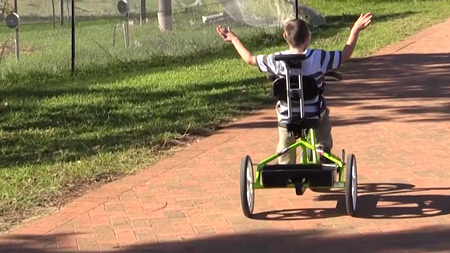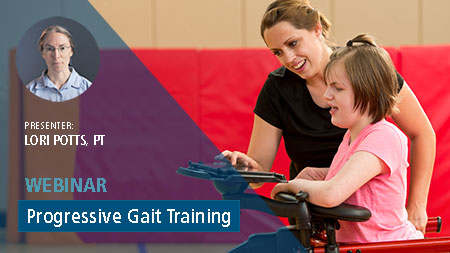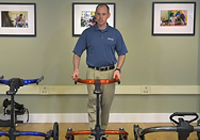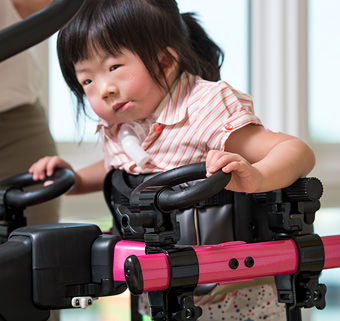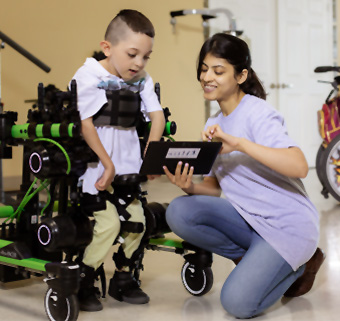Benefits of Dynamic Movement in Gait Training
Lori Potts, PT discusses how dynamic support options lead to better gait training outcomes.
[00:03] Lori Potts, PT: Welcome to this presentation on the topic of the benefits of dynamic movement in gait training. First we’ll discuss dynamics of gait, then look at available research in dynamic gait training, and then a review of available research with children – primarily cerebral palsy. We’ll look at a few case studies and case stories as well.
[00:27] To begin with, let’s look at the human gait cycle broken down into phases. We’ll follow the child’s right grayed out leg through one full gait cycle. See how the foot makes contact and the leg loads; and as the right leg achieves mid stance, the center of mass is higher, and that enables the left leg to swing through. Then the body moves forward and the right leg lifts off to swing. And as the right leg is in mid swing, the left leg is now in mid stance again, with the center of mass higher. So as the gait cycle takes place, the center of gravity of the individual is following a smooth, sinusoidal curve – a rhythmic up and down movement – with the highest point at mid stance, with that full weight bearing on one limb. And the lowest point is actually when the body weight is shared between both limbs.
[01:23] So when people are walking, there’s subtle shifts in the body up and down and from side to side. There’s actually a five centimeter or a two inch displacement up and down during walking. So this up and down motion also contributes to the body’s ability to store and release energy for that efficiency in gait. Lateral displacement of the center of gravity also follows a smooth sinusoidal curve, also with an average displacement of five centimeters or two inches, and this is referred to as weight shifting. During the stance phase of gait, the center of gravity moves laterally toward that planted limb, making it easier to swing the contralateral limb through to take a step.
[02:06] So when talking about dynamic gait systems, we’re focusing on the device’s ability to accommodate the movement of the center of gravity, because restricting movement will hamper that naturally occurring mechanics of step taking. Here’s another visual that makes the point. The stance leg is essentially an inverted pendulum allowing the center of mass to move in an arc, conserving the mechanical energy. And that explains the efficiency of gait so no mechanical work is needed to lift the body. There’s no actual knee torque to support the weight. And as the walking speed increases, so does the forward movement, with longer and faster steps.
[02:52] On the next slide we see the swing leg, and how again the pendulum enables that long stride with a low cost of effort. And as we see the diagram of the longer and faster step, the stride is lengthening as the walking speed increases. So the swing leg is moving like a pendulum and conserving energy.
[03:19] Here we see the interplay of potential energy and kinetic energy. So speaking of the efficiency of gait, we have the body’s ability to gather and store and release energy for that high level of performance. Imagine riding a bicycle down a hill. You pick up enough speed and energy to make it part way up the next hill without having to pedal. So the body during gait works in a similar way. You’re gathering energy from the impact force of the foot hitting the ground, and storing that as potential energy, and then releasing it through the rest of the gait cycle until your foot hits the ground again. So gait dynamics allow a lot of walking to be produced with little effort. And this has functional significance for gait training, because we want to avoid excessive amounts of displacement of the center of gravity and reduce energy expenditure, by providing supports that enable that fluid gait pattern.
[04:22] Here’s an interesting quote from a doctor in Russia. He said that “No person walks completely straight. And this is evident when looking at a person wearing a headlamp in the dark and walking toward you – because the light moves up and down and from side to side. And this is even more evident when a person is walking slowly in order not to fall…so we see the relevance of this for people with ambulation disorders.” We want to provide support that allows the dynamics of human gait, and that the body is not having to fight against, to achieve the walking. As mentioned by the doctor in Russia, with slower gait the medio-lateral displacement becomes even more evident. And this research with normal individuals found that at slower speeds, the medio-lateral displacement increases.
[05:21] The smallest circle that you see is that slowest walking speed measured; and they measure the step width of the footprint, and it’s widest at this slowest speed. Then as the walking speed increases, that lateral excursion decreases; so even with the same person, that lateral movement is varying during gait depending on their parameters of speed. So we want to accommodate that. This slide summarizes and takes a look at a top view, looking down at the individual walking. We see the side to side gait. We discussed the vertical up and down movement. And there is a slight four degree rotation component as well, that further smooths the trajectory and advances the limb during the swing phase, increasing that step length for energy efficiency.
[06:22] So there’s a lot happening during the gait cycle. The legs are moving, the whole body shifts up and down and from side to side for a very energy-efficient gait. Now there’s very little research so far on dynamic gait training systems, but we do know that systems that move up and down improve the constancy of the vertical unloading during gait. By providing bodyweight support that moves along with the movement of the subject’s center of gravity, that results in more natural ground reaction forces and gait characteristics.
[07:04] In 2006, Frey and colleagues set the groundwork for this research with a Lokolift system. the Lokolift provided dynamic bodyweight support and showed that constant and vertical unloading of the body during gait provided near-normal ground reaction patterns compared to static unloading systems, and this research was expanded upon by Hidler et al. in 2011 with their ZeroG, as well as in 2016 by Munawar and colleagues, who did similar work with an elastic body weight system, compensating for the body’s inertia. So the findings were that dynamic body weight support produces more natural ground reaction forces and gait characteristics.
[07:57] And this graph is the comparison done with the Lokolift device. They measured bodily unloading and the ground reaction forces during ambulation of individuals using three different body weight systems. The Lokolift was dynamic compared to a static body weight support, and then to a counterweight system. So each system provided about sixty kilograms of unloading body weight support during walking. They had healthy subjects in the body weight support system. And as you can see here, the dynamic Lokolift provided the most constant, smooth and even unloading at or near sixty kilograms. And that compares to that fluctuation of the other two body weight systems.
[08:48] So what we see is that during each step in gait, especially at the single and stance phase, the amount of unloading was much less with the static systems, because the support did not provide for that up-down motion during gait. Similarly, the counterweight system was also not as ideal…where there was a constant unloading, as long as the patient didn’t move. But once the patient started walking, then there was some oscillation of the unloading force. Our conclusion here is that the dynamic body weight system was the most effective.
[09:26] Here’s a little more data from the 2006 study. They looked at ground reaction forces of the individuals walking in each of the systems, comparing it to the person walking independently without support. And that’s the very top graph – is the individual walking normally without any support. And notice how the ground reaction force cycle – which is patterned after the gait cycle with the plateau phase, followed by a ground force peak, just before it drops to its minimum – that very similar ground force pattern was observed when walking with the dynamic bodyweight system, the Lokolift, which is the second graph.
[10:09] And you can see then the contrast to the loading and ground reaction forces with the other systems. So the physiological gait kinematics and ground reactions provide that feedback. And it’s believed to be important for successful gait rehabilitation, to have as natural kinematics and as close to typical walking patterns as possible. The dynamic bodyweight support provides this the best.
[10:40] Here is some research by Dr. Lowe. She investigated differences in gait characteristics and mobility of children with cerebral palsy when using two different gait trainers. One was a dynamic frame, allowing for up and down displacement; and the other was a rigid frame. So the children had two weeks of practice in each gait trainer before the data collection. And for the subgroup of children with no previous gait trainer experience, there was a statistically significant increase in velocity, which is the distance covered in one direction per the amount of time. Also an improvement in cadence – the quality of rhythm and regularity of their stepping movement – and an improvement in their timed functional walk. So the child’s self-paced walking function was faster with the dynamic gait trainer.
[11:33] This little girl began a walking program six months after she sustained a complete T10 spinal cord injury at twenty-three months old. At first she began with a posterior walker and hip knee ankle foot orthosis. She was dependent for all stepping requiring manual assistance to move each foot forward, and she reported pain and fatigue with the effort. Three months later, her therapist introduced a dynamic gait trainer to keep her motivated to walk. This device has pelvic support, which is dynamic in three planes, encouraging a typical walking pattern. And they found that it decreased her fatigue and pain, she could now be on her feet for up to an hour, and she participated in a dance class. Over four years her walking progressed. She no longer needed trunk support and she could walk with reciprocal stepping for up to forty yards within six minutes.
[12:34] Another benefit with all this physical activity was that she did not develop contractures, and her bowel and bladder elimination improved, as reported by her family. So this gave her access to community activities. And even though her sensory motor recovery did not change below the lesion, just by virtue of the device, she was able to improve her activity and her participation.
[13:11] This brings us to further research on pediatric gait training. Although this does not differentiate between dynamic versus static gait trainers, it does give us information about the use of gait trainers for this population. The 2020 survey in the United Kingdom had 125 survey respondents, and 107 of these were prescribers of support walkers; whereas eighteen of them actually worked with children who used support walkers. In the 2011 survey, there were 513 respondents in the US, all of whom were pediatric PTs and their clients used support walkers. All the respondents to the survey reported that the highest benefits included physical activity and participation and improving independence.
[14:07] The other findings that you see here were secondary, but were also reported. In published research, the systematic review is considered the highest level of evidence. Articles in a review have been critically evaluated. Only studies that meet the criteria are included, so there may be many small low-level studies published, but only the ones that meet this rigorous selection criteria are selected.
[14:36] So these three systematic reviews on pediatric gait training are definitely of interest. The 2020 review by Chiu focused on children with cerebral palsy, three to eighteen years of age. And the 2018 review by Booth also looked at children and young adults with cerebral palsy. And their review actually included forty-one studies with eleven of those being randomized controlled trials. The 2015 review by Paleg focused on children of all diagnoses who were non-ambulatory and unable to walk with a simple handheld walker. So functional gait training is defined as actively practicing the task of walking – be it overground gait training, treadmill training with or without bodyweight support, and using devices that may be static or dynamic.
[15:30] In the 2020 review, protocols varied but typically we saw gait training anywhere from fifteen to forty minutes in a session, and doing this two to five times a week for four to twelve weeks. So gait training drives skill acquisition directly as it relates to walking, because it’s the repeated practice of that specific motor task. So we see improved walking speed as the most commonly reported outcome. Other findings are distance or number of steps. And the Booth review also found consistent evidence to support improvements in walking endurance. There were measurable improvements in gross motor function as well, such as sit-to-stand transitioning. The findings regarding participation are evident but not as extensive, and that may relate to types of gait training used.
[16:29] These two systematic reviews specifically looked at treadmill training, and the measurable benefits include improving motor function, balance, endurance and walking ability. The 2015 review by Ronan concluded that both partial body weight support and full body weight support show promise as an effective intervention technique for children with CP. Children with CP can make improvements using shorter duration or higher intensity programs, as well as with longer duration and lower intensity programs.
[17:02] The 2017 review shows that treadmill intervention can accelerate the development of independent walking for children with Down syndrome, and may also accelerate motor skill attainment in children with cerebral palsy or general developmental delay. After the systematic review, the randomized controlled trial is the next highest regarded research. These two randomized controlled trials both show that treadmill training may be no more effective than overground gait training for improving walking in children with cerebral palsy. There was no measurable distance in walking endurance, walking speed or walking function; and with the overground group, there was actually a trend toward an increase in the distance walked in ten minutes. So this may suggest or does reflect the importance that treadmill training needs to be followed by overground walking practice, because adding that concurrent overground walking training can assist with carryover to the improvements of actual overground walking.
[18:11] These studies were not randomized, controlled trials; nevertheless, the findings are interesting. The researchers took the same group of children and observed them performing walking overground and walking on a treadmill, and recorded the outcome measures without a control group. And they found when the data was analyzed that children walked with longer and faster strides and better range of motion when they walked overground. Interestingly, the amount of body weight support did not impact differences in gait, so the walking performance depended more on the walking surface.
[18:48] So consider that the treadmill isn’t an environment children typically ambulate on, but can be an effective gait training practice when combined with overground gait training. We will round up our discussion on gait training with examples of actual case studies. This case study was published in a peer-reviewed research journal in 2017, the Journal of Neurologic Physical Therapy. The individual is pictured at the top right of the slide here. This was at the time of his traumatic brain injury, due to a motor vehicle accident. And then the picture on the lower right is the patient Sean Carter with his physical therapist, Karen McCain, the author of the article.
[19:37] And the case study makes the point that recovery is possible even four years after the traumatic brain injury with persistent, task-specific practice. The patient received gait-related interventions in a variety of means, delivered over a year and two or three months. And even outside his therapy sessions, he did walking practice with a Rifton Pacer. So on the next slide we’ll see a video showing that initial progress he made over less than three weeks span, and then subsequent videos showing his progress after a year. And this progress was made following principles of motor learning neuroplasticity with lots of task specific practice. I’ll just mention that one of the videos shown is actually when Sean visited the Rifton factory to show his appreciation for the product with which he made his progress.
[20:54] Jenny Carter (Sean’s mother): This to us is the first step of the rest of Sean’s life. We’re giving him the ability to walk again. It’s the Rifton Pacer gait trainer. And Dr. McCain in all her experience said that this is the one device that can lead him to walking again.
[21:20] Karen McCain, DPT: It’s a device that’s perfect for patients like Sean because it has a lot of support. But then you can also sort of peel away the support as he gets better. It has a chest prompt, so it gives him support at his chest. It has arm supports, it has thigh supports. So it can give him all the stability that he needs; but as he gets better I can take some of that stability away. Because he has the ability to move his legs, but he doesn’t have the stability in his trunk and in his neck and in his upper body to be able to propel himself over ground by himself. But he needs to be able to walk a lot to be able to learn the skill. He can’t do it coming to therapy twice a week for an hour, so he has to be able to walk outside of therapy. And this device will let him do that.
[22:07] Move your leg back here, big guy. Bring this leg back. Bring your right leg back. There you go…perfect! Now stand up really straight. So whatever position you really like, then you need to tighten this baby down...
[22:49] What we’re trying to do with Sean is to get him to relearn how to control his own movements. When we first started working with Sean, we had him on the treadmill so that he could re-pattern just the basic leg movements, so that he could remember sort of how to reciprocally step one foot after the other. And now he can really do that. We don’t have to move his legs for him at all. But what now he’s having a hard time with is learning where to put his body in space, so that he can shift his own weight and learn to propel his own body. So that’s really sort of where we are now. He has limitations in his body. He’s tight in some places and stiff, and it’s different than before his injury. So now he has to learn how to move his body with those limitations. So the gait trainer is a great tool, because it gives him stability while he learns to move in his new body so to speak, because he really hasn’t had the chance to do that since his brain injury.
[23:43] Don’t pick up that other one until you feel all the weight on this foot. That’s it now moving!
[23:56] He’s come a long way, a long way. I think the future is great for Sean; he’s really progressing quickly, especially since he’s been sitting in his chair for over four years.
[24:45] Jenny Carter: We wanted you to see Sean to really know there’s a real person using your equipment that’s benefiting from it. We just thought, you know, we just wanted to come.
[25:07] Lori Potts: Here is another case study. This was published in 2012 in the peer-reviewed research journal, Physiotherapy Theory and Practice, and this study focused on bodyweight-supported treadmill training. An eighteen year old male with spastic cerebral palsy who was not a functional ambulator, presenting with atypical tone and contractures and significant functional weakness, actually using a wheelchair for all mobility, was able to ambulate with the support of a bodyweight system over a treadmill. And remarkably he made substantial gains over six weeks, where his endurance improved and his mobility, such as reported by his family, in terms of transfers into his van or onto a toilet as well as other self-care domains, improved indirectly as well. So using the treadmill in the case of a situation like this, where overground walking is too high of an energy demand, was a great alternate for physical activity for him.
[26:18] Here is an unpublished case story contributed by Connie Johnson. She’s a school-based PT in Fairfax County Public Schools in Virginia, and she compiled data with one of her students, Rachel, a fifteen year old with cerebral palsy. So she was independent with the use of a motorized wheelchair, but only used a gait trainer during adaptive physical education class or to access the bathroom – maybe 300 feet a day. But this therapist trialled Rachel on a treadmill with her Pacer gait trainer two or three times a week, and she did also continue her overground walking in the school routine as well as other exercises.
[26:58] But here we can see over three months how she increased her walking tolerance from ten minutes to twenty minutes, and over the course of one month when walking two tenths of a mile, she also increased her walking speed. Most important of all, perhaps, is her level of enjoyment in the activity. She loves walking on the treadmill with this gait trainer, listening to her favorite music, and gets off sweaty and happy. So she’s really getting the benefits of exercise-induced endorphins, and it makes a great option for her.
[27:33] Ben is a tall, active twenty-one year old with global developmental delay. He can present with sudden drop seizures and poses a challenge with his large size and poor balance. So he uses a helmet to prevent head injury in case of a seizure or fall. So even though he’s fully weight-bearing and can walk, it requires two or three staff to keep him safe while walking. The benefit of the gait trainer for him is that he’s comfortable, safe and can walk with the supervision of one adult. And the dynamic movement of the frame gives him a great freedom of movement. He has tolerated walking for up to an hour at a time, and this has benefited his weight loss program as well. So we will watch a short video clip showing his success with the Pacer.
[28:25] The free-floating dynamic system allows for the subtle but natural movements that occur with walking, enabling Ben to move his center of gravity smoothly and easily instead of fighting against the device. Ben is enjoying more freedom of movement. With dynamic movement, walking is more energy-efficient. For the first time, Ben has tolerated walking for up to an hour at a time.
[28:51] And we’ll close with our final case story. This is Saad. He is a twenty-two year old, just graduated from his school system and transitioned to an adult services program. He does have cerebral palsy and developmental disability, with a history of leg surgery, and came to the program in a wheelchair. The program started him out in a standard rigid gait trainer, but he had some difficulty with navigating himself out of corners or around furniture, and often required help. A month later his parents got him a Rifton dynamic gait trainer, and he went from walking stiffly to literally running – and has now built up so much speed that they’ve had to apply the drag function on the casters to slow him down a little. He also has a lot less trouble navigating in tight spaces, and does great with engagement with his peers and various sports activities. So this is a great story of success.
[30:03] So that wraps up our discussion on dynamic gait training and thank you for your participation.
